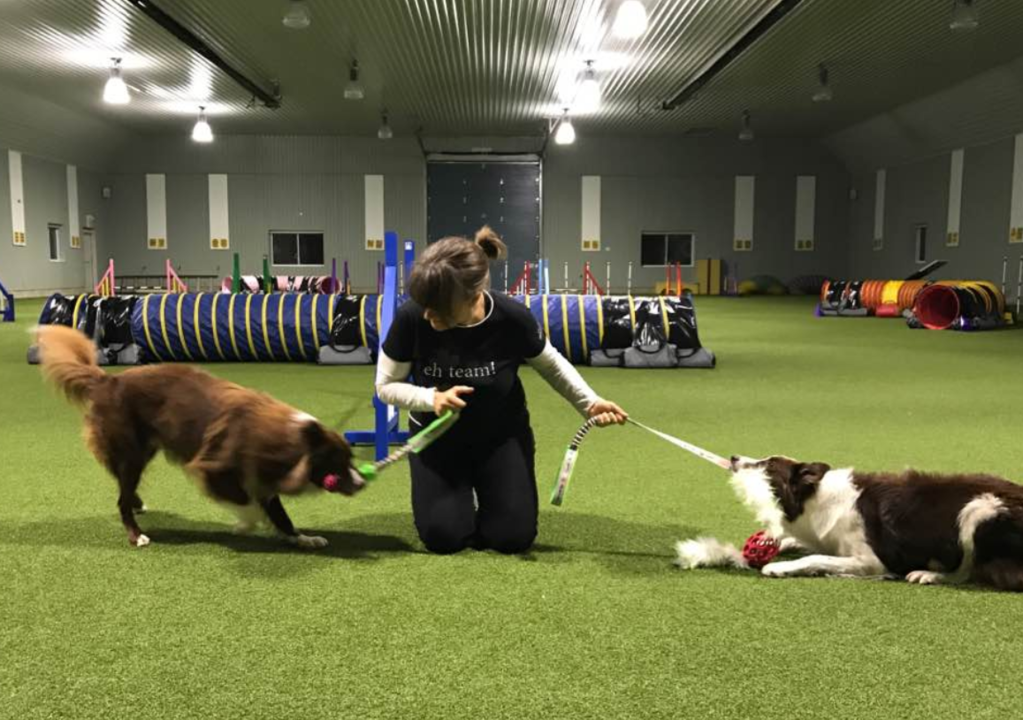
Tugging is a big part of my dog training, I hope it is also a big part of yours. It is a great reinforcer for most dogs. For those dogs that are not currently big fans of tugging, it is a skill that be cultivated with work on your part . . . yes I know it sometimes seems like a LOT of work. Start by creating a motivating toy.
Lately, I have been observing young dogs tugging in different environments. I don’t want to talk about the mechanics of the activity itself (although I have a lot to say about that:)) but I would like to focus on the results I have observed that tugging is producing. Now these are generalizations I am about to share, but the number of dogs that have presented with the same responses, to me, make the results pretty darn compelling.
First here is what I noticed. A young dog tugging with his owner in a distraction filled environment, lets say it is at an agility trial with lots of commotion and dogs running everywhere. What do you suppose this dog does when the tugging stops? That is what I have been observing and what got me thinking of why? With many dogs, the moment the tug comes out of the dog’s mouth the dog spins around to focus on the “other activity.” The distractions, the motion that immediately catches their eye.
Then I started to think of my own young dog “Swagger” (who is approaching his first birthday later this month). When I take the tug away from Swagger in any environment, he grows in intensity for me, his focus narrows on my movements. This is not unlike any other dog I have trained; so it can’t just be “the dog” (although I do think Swagger is pretty special:)). It has to be something I have done or not done as I have raised my dogs that has created this focus.
Here is what I think it is, and I believe this could make a MASSIVE difference to everyone with young dogs or dogs that are struggling to give you their full focus at work. The difference I see lies in the . . .
Duration of the tug session.
Many people when they tug with their dogs, do it as a duration behaviour. It goes on forever. It is mindless. The tug toy is a “baby sitter” as they chat with their friends. If there is a potential distraction near by, then tug game becomes a game-on-the-run where the dog is attached to the toy which is attached to the owner for the entire time it takes to get passed the distraction. It is a duration activity. It can last seemingly forever (at least 30 sec – 1 minute) but certainly much longer than I tug with my dogs.
 With these dogs the history of using tug as a reward is one where the dog is engaged for an extended period of time. By the time this tug game ends the trainer is often exhausted and the dog so over aroused he has difficulty thinking straight. He is all revved up when you are pooped out!
With these dogs the history of using tug as a reward is one where the dog is engaged for an extended period of time. By the time this tug game ends the trainer is often exhausted and the dog so over aroused he has difficulty thinking straight. He is all revved up when you are pooped out!
By way of contrast when I reward a dog with a tug, it is a very short session. The reward process itself may take the same length of time as any of the “extended tugging sessions” but with one major difference. My reward process would be filled with multiple sessions of quick tugging spaced out with me asking the dog to something in between each tug session. This would be especially true if I was trying to get through a distracted environment with the dog.
The tugging itself would be anywhere from 3-10 seconds, maybe less. I let it go on for as long as it takes to get sustained, sincere, fun, tugging … no re-gripping, no looking else where. When I get that, I end it. BUT the moment I end the game of tug I immediately engage my dog in the next phase by asking him to do something else, like a hand touch which starts another game of tug. Or a game of PB&J (“Push Back & Jam” where I take off on my dog and when he catches me we start another short lived game of tug). Maybe I will then do a 360 degree spin into another game of tug or just ask for a quick sit, down or stand, move away a couple of feet, take a deep breath, let it out slowly, release my dog, run & tug again.
Short tug session, quick cued response followed by another tug session. This pattern is mixed up just about any time I reward my dog. Sure some times it is a quick tug and back to our regular training and occasionally I may even do the odd “duration tug” but that is rare.
So, from a dog training point of view, why does tugging in each of these two ways result in such a different behaviours in the dog? Why do most of the “duration tug dogs” focus on their environment when the tug game stops and the quick tug session mixed with other responses create focus for the handler?
Let me know your thoughts and I will share mine later. Fascinating stuff I think.
Today I am grateful for all of the dogs who happily reveal what they have learned from us with anyone who is willing to take the time to observe them. Gotta love dogs!






I’m thinking that the “duration tug dogs” know that the game is over and they adapt the next best rewarding behavior while Susan’s dogs are looking for the next game from her so they stay engaged.
I’m really confused with releasing? How do you do it do you use a word or some sort of signal?
So good! My adopted two year old had no interest in tugging whatsoever (she’d been raised chasing balls), and I didn’t realise how important tugging is – now that I am in recallers etc, I have been enlightend! lol – and this blog is a great polisher. I am so proud of my adult dog and now my new puppy who can tug like a boss 🙂
This couldn’t have come at a better time. I know my tugging sessions were too long just not how long they should be. Now I know and can implement in my training sessions.
Great reflexion as always!
Great points, Susan.
Nearly every police dog candidate comes from Europe thinking that possessing the tug is the point of the game. It takes a while for them to get that the tug is actually the vehicle for the GAME with their own personal hairless primate.
Within one week of having their dog you can tell which handlers will have an easy time of the K9 Academy which won’t. Simply put, it’s the ones who develop such good GAME that their dogs crave more after a brief tug, and who know how to ramp it up and down that really connect with their dogs.
Yes, Susan, less is more. . . as long as that less is REALLY connected with the dog
Excellent! This is what I’ve fallen into quite by accident and it is working as you suggest. Our current struggle is getting him to stop. Drop it is the cue that seems to work. It’s a handler mechanics issue keeping the long tug toy and not luring or distracting him while asking him to do something else.
Brilliant as always. So helpful.
Question: How do you release them from their cued response into the next tug session?
“Break” is my catch-all release, although depending on the situation, it might also be “search,“ “get it,” or my recall whistle.
Since these are very quick games, I’d love to know if you have a standard recommendation.
Thank you!!!
3 weeks into Recallers & this is the exact info I need. I’m making tug too long / not integrating it with quick focus tasks and doing too much of the tug work myself!! Looking forward to our next session.